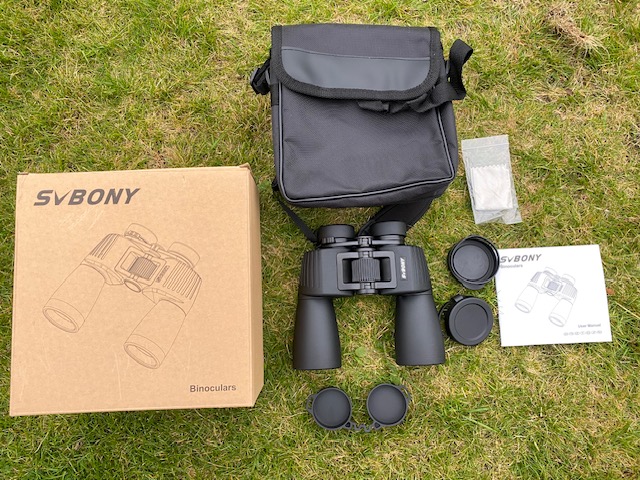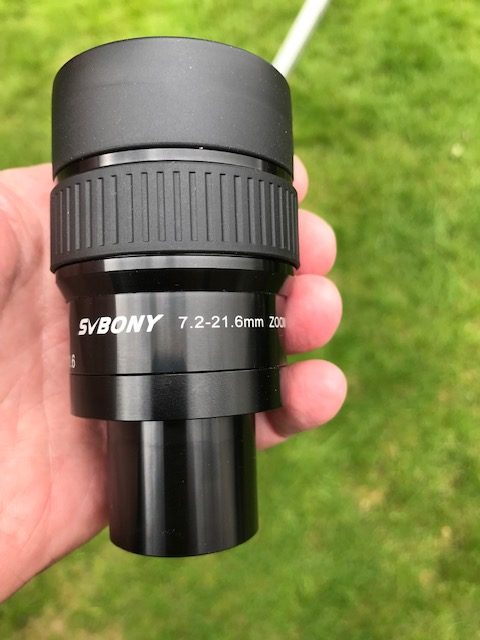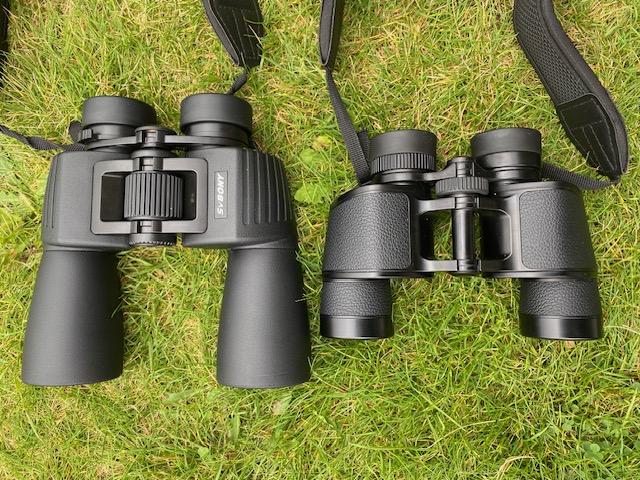
A Work Commenced September 17 2023
Product: SvBony SA204 10 x 50
Country of Manufacture: China
Exit Pupil: 5mm
Field of View: 114m@1000m(6.5 angular degrees)
Eye Relief: 19mm
Closest Focus Distance: 6m advertised, 5m measured
Chassis Construction: Rubber-armoured aluminium
Prisms & Coatings: BaK4 prisms, fully multi-coated
ED Glass: No
Waterproof: Yes, IPX6 rating
Nitrogen Purged: Yes
Dioptric Compensation: +/-4
IPD Range: 53-74mm
Tripod Mountable: Yes
Dimensions: 17.5 x 19.8 x6.4cm
Weight: 925g advertised, 875g measured
Accessories: Padded neck strap, rubber rain guard and objective covers, instruction manual, soft padded case
Price: US $84.99
Ever since its founding in 2009, Svbony has been delighting the astronomy and sports optics community with an expanding range of high-quality products offered at very affordable prices. SVBONY is an acronym which stands for Saturn(S), Venus(V), Birding(B), Optics(O), Nature(N), Youth(Y). I was first introduced to the company a few short years ago when I stumbled on their excellent SV202 ED roof prism binoculars, which have since gone from strength to strength and are now being enjoyed by an army of nature enthusiasts the world over. Not long before this time, consumers were left with very little option to shell out significantly more money for products that often left a lot to be desired quality-wise. Be sure to check out the most recent reviews of these binoculars. Since discovering the SV202s, I have also enjoyed some of their excellent spotting scopes, and regularly use some of their high-quality zoom eyepieces, like the SV191, which I’ve begun to employ extensively this season to observe Jupiter.

As a dedicated fan of Porro prism binoculars, I’ve steadily come to realise their exceptional value for money owing to great advances in technology, as well as their much simpler design compared with high-performance roof prism binoculars. Truth be told, it takes a lot of knowledge and technology to create roof prism binoculars that can even begin to approach the quality of a traditional, well-made Porro prism design. What’s more, many of the conventional objections purists have laid against the humble Porro prism binocular have now been satisfactorily addressed, including advances in anti-refection coating technology, water- and fog-proofing, and the introduction of modern twist-up eyecups with much better eye relief to accommodate eye glass wearers. In addition, advances in material science also means that good Porro prism binoculars can now be manufactured with lower mass chassis, allowing them to be carried longer in the field.
It was these considerations, as well as my own experiences with several budget-priced Porro prism models that led me to appraise one of Svbony’s newest products, the SA204 10 x 50, a traditional Porro prism binocular. Having ordered several products directly from their online store, I decided to purchase this instrument directly from Svbony too, since they’re currently not available from Amazon UK.
First Impressions

The SA204 10 x 50 package took about two weeks to arrive from the Far East to my home. As usual with Svbony, I was extremely impressed with the attention to detail in how it was packaged during its long trip to the UK. The instrument arrived double boxed inside some bubble wrap to ensure that nothing moved out of place during transit. All the accessories were also neatly packed away, including the ocular and objective covers, a carrying strap, lens cleaning cloth, a well-written instruction manual and a decent soft padded carry case. Inspecting the binocular, my first impressions were very favourable. The instrument is covered in a high-quality textured rubber substrate, ribbed at the sides for extra grip. The twist-up eyecups moved smoothly and were easy to adjust, keeping their individual positions firmly when clicked into place. Two intermediate positions are available between fully retracted and fully extended, so plenty of options for those who like to experiment.

The aluminium central hinge is nicely tensioned, allowing you to easily adjust it to your preferred IPD. Once there, it stays rigidly in place. The rubber-covered central focus wheel has deep ridges to afford extra grip. Turning is very smooth with no free play. It ‘s quite stiff though, a consequence I suppose of the instrument being properly sealed and nitrogen purged. The focuser moves the eyepiece assembly up and down with no annoying wobbles I’ve seen in other instruments in this price class. 0.8 turns anticlockwise takes you from closest focus to jut beyond infinity. Eye relief is very generous. I was easily able to engage with the entire field using my varifocals, although I don’t wear spectacles when glassing under normal circumstances.
The dioptre adjustment is made using a small lever under the right eyepiece that rotates either clockwise or counter-clockwise, and I was easily able to find my optimal position. Once set in place, it stays there. I would say it’s very nicely engineered.

The large ocular lenses have nice green multi-coatings and the objectives are decently recessed as all good binoculars ought to be. The objective coatings appear to be significantly more subdued to those applied to the ocular eyepieces and I detected a faint reflection off one of the interior lenses possibly indicative of one surface being singly coated. The rain guard and tethered ocular covers are quite basic but do an adequate job protecting the lenes from rain and dust.

The instrument feels really nice in the hand with plenty of wiggle room to engage with my medium-sized mitts, making it easy to hold the instrument firmly. I was pleasantly surprised by the weight of the instrument without the strap and lens covers. Although the specs claim 925g, my SA204 tipped the scales at just 875g or 50 g less than advertised! All in all, I came away with the impression that this was indeed a nicely appointed binocular, significantly better built than other 10 x 50 Porros I’ve tested in the past, including the Opticron Adventuer T WP and the Nikon Aculon.
Optics
My optical testing began by measuring the effective aperture of the instrument by directing my iPhone 11 torch into one of the eyepieces and measuring the size of the resulting circular shaft of light emerging on the other side of the objectives. By tracing a circle of diameter 50mm, I was able to show that the circular light shaft fitted snugly into the circle indicating that the SA204 was operating at its full aperture.

In the next test, I examined how well the binocular handled a beam of bright light. Turning on a sodium street lamp after dark, I was relieved to see that only a few minor internal reflections were seen that were largely non-injurious to the image. There was no diffused light around the light ether. Consulting my notebooks, I reported a little more internal reflections for both the Nikon Aculon and Action EX Porros(both of which retailing for considerably more than the SA204) I reviewed some time back and about the same as I recorded with two models of Opticron Adventurer T, but not quite as good as that seen in the significantly more expensive Opticron Imagic TGA WP(a £200 value).
Looking at the exit pupils yielded quite good results. I recorded nice round circles but I could see some light leaks around the pupils suggesting that better blackening on the inside of the tubes wouldn’t have gone astray.


I had the opportunity to test the SA204 in all kinds of lighting conditions. The image is quite good: sharp, nice contrast, with a surprisingly large sweet spot. Colour fringing is very well controlled, especially off-axis.In this capacity, it’s certainly in a completely different league to the Nikon Aculons I tested, which displayed alarming levels of lateral colour to my eyes. Glare suppression is quite good too. I discovered that by retracting the eyecups one notch down from fully extended improved both the visibility of the field stops and the amount of glare I recorded. The instrument has an impressively wide field of view of 6.5 degrees with very well-defined field stops. I did perceive some peripheral softness near the field edges but it was not at all objectionable to my eyes. The instrument does display strong pincushion distortion however. I took the liberty of photographing some pink flowers at a distance of about 30 yards to give the reader an idea of how well corrected the field is:

Close focus was measured at about 5m, less than the 6m advertised, putting it in the same ball park as a few other 10 x 50 Porro’s I’ve used. Of course, an instrument like this excels under the stars, where the 10x magnification and 50mm objectives pull in a lot of starlight. I checked collimation under the stars by defocusing the bright star Capella using the right eye dioptre while keeping the left barrel image as sharp as possible. The focused star remained well inside the defocused anulus not only in the centre of the field but also when placed to the extreme north, south, west and east edges, indicating very accurate alignment of the left and right barrels. Examining the Alpha Persei Cluster high up in the eastern sky reveals a rich cache of stars scattered across the field, I was delighted to see that they remained acceptably small and sharp across most of the field with only the outer 20 per cent of showing some mild distortion. But even at the field stops bright stars like Vega and Altair remained quite tightly focused. Moving bright stars to the edge of the field showed little in the way of illumination drop off either. These results were most impressive for a large binocular retailing for significantly less than $100. Indeed, this instrument can be used to very good effect for general stargazing.
I estimated the field size by trying to image Alkaid and Mizar in the Plough, which have an angular separation of precisely 6 degrees 40’ or 6.66 angular degrees. I was unable to keep both stars in the same field of view but only just so, indicating that the advertised field size of 6.5 degrees was quite accurate. Views of the bright waning Moon rising over the eastern hills showed very nice results, with excellent crater detail coming through across the southern Highlands. There were a few minor internal reflections seen around the silvery orb, but they weren’t judged to be too offensive. I could detect a sliver of chromatic aberration at the edge of the Moon when centrally placed in the field but this could be largely ameliorated by carefully reconfiguring eye placement. Off-axis colour fringing was more obvious though, but nothing I would describe as being out of the ordinary.
There was one negative however, and it manifested itself as I was imaging star fields in the vicinity of some streetlamps. Some of this peripheral light was entering the field, brightening the background sky by a tad. This disappeared however when I moved to the darkest location in my garden away from such light sources. In contrast, my Nikon E II 10 x 35(retailing at nearly ten times the price of the SA204) handled this stray light much more effectively. That said, I don’t count this as a major issue, and Svbony would do well to blacken the inside of the barrels that little bit more effectively.
Aperture Wins!

Lest anyone be uncertain about the benefits of aperture, I took the opportunity to test both the SA204 10 x 50 and Nikon E II 10 x 35 under a dark country sky with no Moon during the wee small hours of September 17. Turning the instruments on the faint galaxy duo M81 & M82 in Ursa Major, I did manage to see them in both instruments, but they were much easier to see in the 10 x 50. The same was true when I moved the instrument to the celebrated Double Cluster in Perseus, now passing near the zenith at about 2.00 am local time. The view was compelling in both instruments, but the clusters were considerably richer in the larger glass. Ditto for the wondrous Pleiades and Hyades in Taurus as well as tracking down the trio of Messier open clusters in Auriga still low in the east. Indeed, I was quite impressed by just how well the SA204 managed to image the Hyades, with its constituent stars filling most of the field. I noted how well defined fiery red Aldebaran presented itself when positioned at the south-eastern edge of the field! All this to show that ‘you cannae change the laws o’ physics captain’ no matter how sexy and optically pristine the smaller, more expensive glass may be.
Conclusions and Recommendations

The Svbony SA204 10 x 50 represents excellent bang for buck. It serves up a well corrected, sharp, bright and high contrast image with good control of chromatic aberration. It will serve as a fine general-purpose binocular, where it excels at low light observations and astronomy. I would have been thoroughly delighted with an instrument like this were I starting out in binocular astronomy again. I would however recommend using a more substantial neck strap than the generic one supplied with a chunky instrument like this. Better attention to internal blackening to improve contrast when observing under bright night lighting would also go a long way to making it an even better performer. That said, if you’re after a cost-effective instrument that does many things well, I would certainly recommend this neat 10 x 50 Porro to all and sundry.

Dr Neil English’s new 650+ page book, Choosing and Using Binoculars: A Guide for Stargazers, Birders and Outdoor Enthusiasts, caters for all budgets and will soon be published in paperback. Now available for pre-order.
This company seems to produce some really good products.
I wish they would/could? sell their stock in actual shops.
I don’t use the internet to buy, I rely on the precious few bricks & mortar shops that are left.
Looking forward to this review to see how it stacks up against the Pentax & Opticron 10×50 porros.
Evening Steve,
That’s the review now completed. I hope that gives you an idea of its performance!
Kind Regards,
Neil.
I’m amazed that for the price of ten pints of Guinness + ten packets of cheese & onion crisps, you can buy this wonderful instrument.
875g for 10X50 porros is very light too.
I would gladly have bought this for astronomy outreach that I used to do.
I too started off in astronomy with a few pairs of 10×50’s and I know that a lifetime of enjoyment can be had with them.
Today’s amateurs have a wonderful choice of instruments.
Really enjoying these reviews.
Good afternoon Steve,
Yes indeed, the days of having to pay out large sums of money to get decent optical quality are well and truly behind us, That’s good news in these times when folk are really feeling it financially,
With best wishes,
Neil.
Dear Neil,
Thank you for your review. How do these compare to the Svbony SV202 10×50?
Thank you,
Ruby
Dear Ruby
The SV202 has better ergonomics and optics.
Kind Regards,
Neil
Thank you, Neil.
You’re welcome Ruby!
Good evening friends, I’m from Brazil and binoculars brands are also missing here, I only trusted SVbony. My question is to observe the stars and the moon, I’ve already decided that it will be a 10x 50. But there are 3 options: SA204, Sv206 and sv202 10×50. There are these 3 options and I don’t know which would be better for observing the stars
Hello,
Out of those you mentioned I would probably go with the SV 202 10 x 50. It’s a very decent performer.
Regards,
Neil
Mas Niel, eu ouvi dizer que para observar as estrelas , astronomia em geral o melhor seria o prisma porro , e o sv202 10×50 , é do tipo telhado. Eu acabei escolhendo o sa204 por ser tipo porro :/
Fiz errado?
But Niel, I heard that for observing the stars, astronomy in general, the best would be the porro prism, and the sv202 10×50, is the roof type. I just found sa204 because it’s kind of cool :/
Did I do it wrong?
Hello Thiago,
There’s no right or wrong way to observe. Just enjoy what you have.
Regards,
Neil
Just took delivery of this binocular, very nice indeed for less then $100 Canadian, minor gripes, neck strap is not padded on my sample but a fairly wide flat woven material, also eye in rain guard doesn,t line up with strap eye on binocular , looked odd so I left the rain guard off the strap. Also managed to get the last copy of Neils book, already getting dog eared from giving me my binocular review fix. Dave.